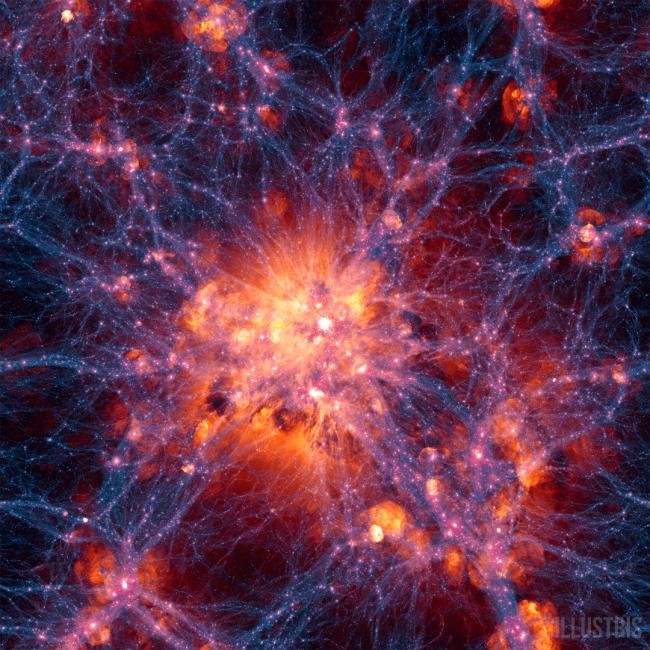- Galaxy Formation and Evolution
- Large Scale Structure
- Quasars & Other Active Black Holes
- Dark Energy and Dark Matter

Cambridge, MA -
Move over, Matrix - astronomers have done you one better. They have created the first realistic virtual universe using a computer simulation called "Illustris." Illustris can recreate 13 billion years of cosmic evolution in a cube 350 million light-years on a side with unprecedented resolution.
"Until now, no single simulation was able to reproduce the universe on both large and small scales simultaneously," says lead author Mark Vogelsberger (MIT/Harvard-Smithsonian Center for Astrophysics), who conducted the work in collaboration with researchers at several institutions, including the Heidelberg Institute for Theoretical Studies in Germany.
These results are being reported in the May 8th issue of the journal Nature.
Previous attempts to simulate the universe were hampered by lack of computing power and the complexities of the underlying physics. As a result those programs either were limited in resolution, or forced to focus on a small portion of the universe. Earlier simulations also had trouble modeling complex feedback from star formation, supernova explosions, and supermassive black holes.
Illustris employs a sophisticated computer program to recreate the evolution of the universe in high fidelity. It includes both normal matter and dark matter using 12 billion 3-D "pixels," or resolution elements.
The team dedicated five years to developing the Illustris program. The actual calculations took 3 months of "run time," using a total of 8,000 CPUs running in parallel. If they had used an average desktop computer, the calculations would have taken more than 2,000 years to complete.
The computer simulation began a mere 12 million years after the Big Bang. When it reached the present day, astronomers counted more than 41,000 galaxies in the cube of simulated space. Importantly, Illustris yielded a realistic mix of spiral galaxies like the Milky Way and football-shaped elliptical galaxies. It also recreated large-scale structures like galaxy clusters and the bubbles and voids of the cosmic web. On the small scale, it accurately recreated the chemistries of individual galaxies.
Since light travels at a fixed speed, the farther away astronomers look, the farther back in time they can see. A galaxy one billion light-years away is seen as it was a billion years ago. Telescopes like Hubble can give us views of the early universe by looking to greater distances. However, astronomers can't use Hubble to follow the evolution of a single galaxy over time.
"Illustris is like a time machine. We can go forward and backward in time. We can pause the simulation and zoom into a single galaxy or galaxy cluster to see what's really going on," says co-author Shy Genel of the CfA.
The team is releasing a high-definition video, which morphs between different components of the simulation to highlight various layers (e.g. dark matter density, gas temperature, or chemistry). They also are releasing several smaller videos and associated imagery online at http://www.illustris-project.org/
Illustris Simulation (YouTube)
Headquartered in Cambridge, Mass., the Harvard-Smithsonian Center for Astrophysics (CfA) is a joint collaboration between the Smithsonian Astrophysical Observatory and the Harvard College Observatory. CfA scientists, organized into six research divisions, study the origin, evolution and ultimate fate of the universe.
For more information, contact:
David A. Aguilar
Director of Public Affairs
Harvard-Smithsonian Center for Astrophysics
617-495-7462
daguilar@cfa.harvard.edu
Christine Pulliam
Public Affairs Specialist
Harvard-Smithsonian Center for Astrophysics
617-495-7463
cpulliam@cfa.harvard.edu
Related News
CfA Astronomers Play Key Role in New Dark Energy Results
Active Galactic Nuclei and Galaxy Cluster Cooling
Astrophysicists Reveal Largest-Ever Suite of Universe Simulations
To Map the Universe, Astrophysicists Launch Largest Sky Survey Yet
Projects
2MASS Redshift Survey
AstroAI
GMACS
For Scientists